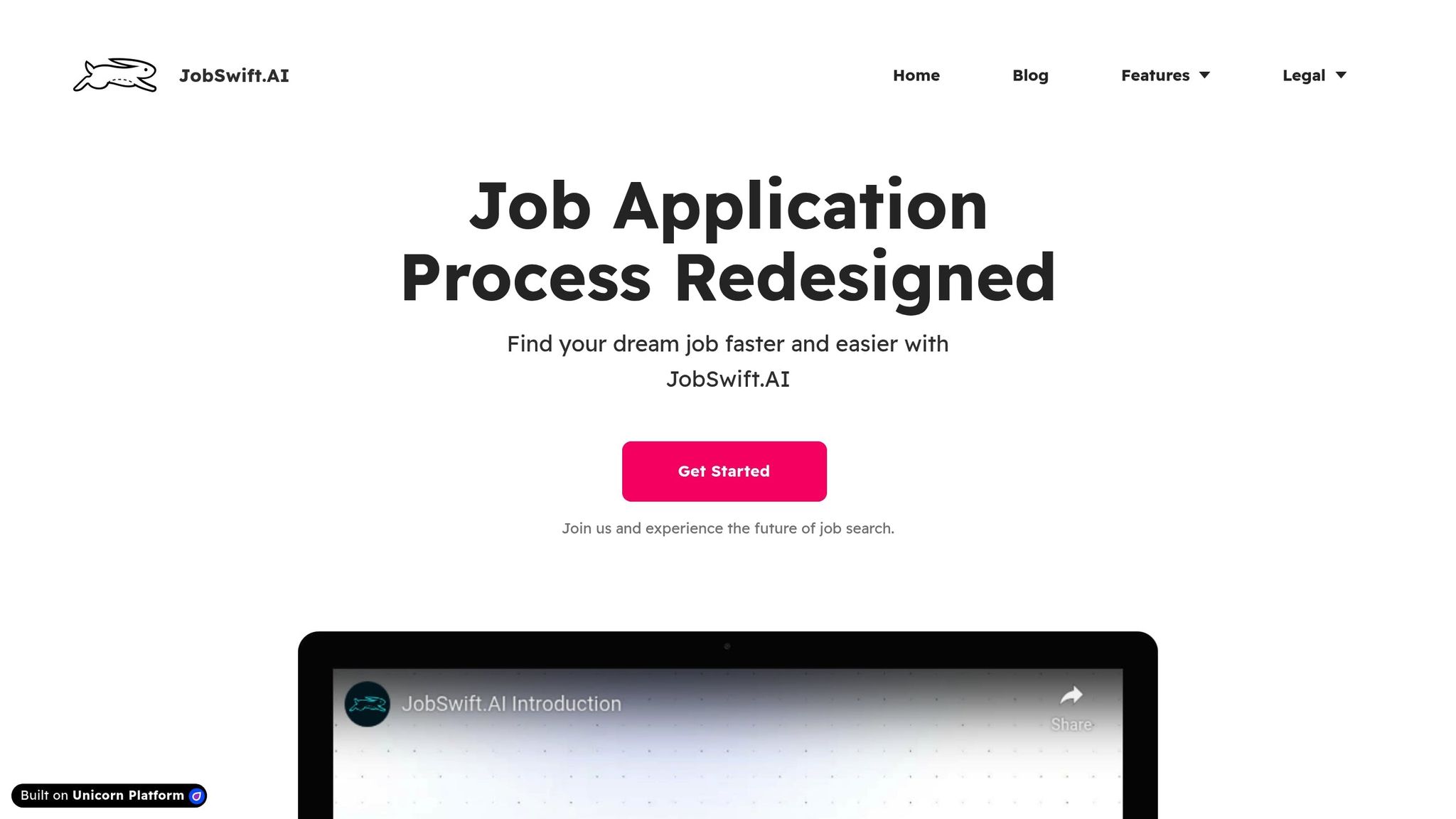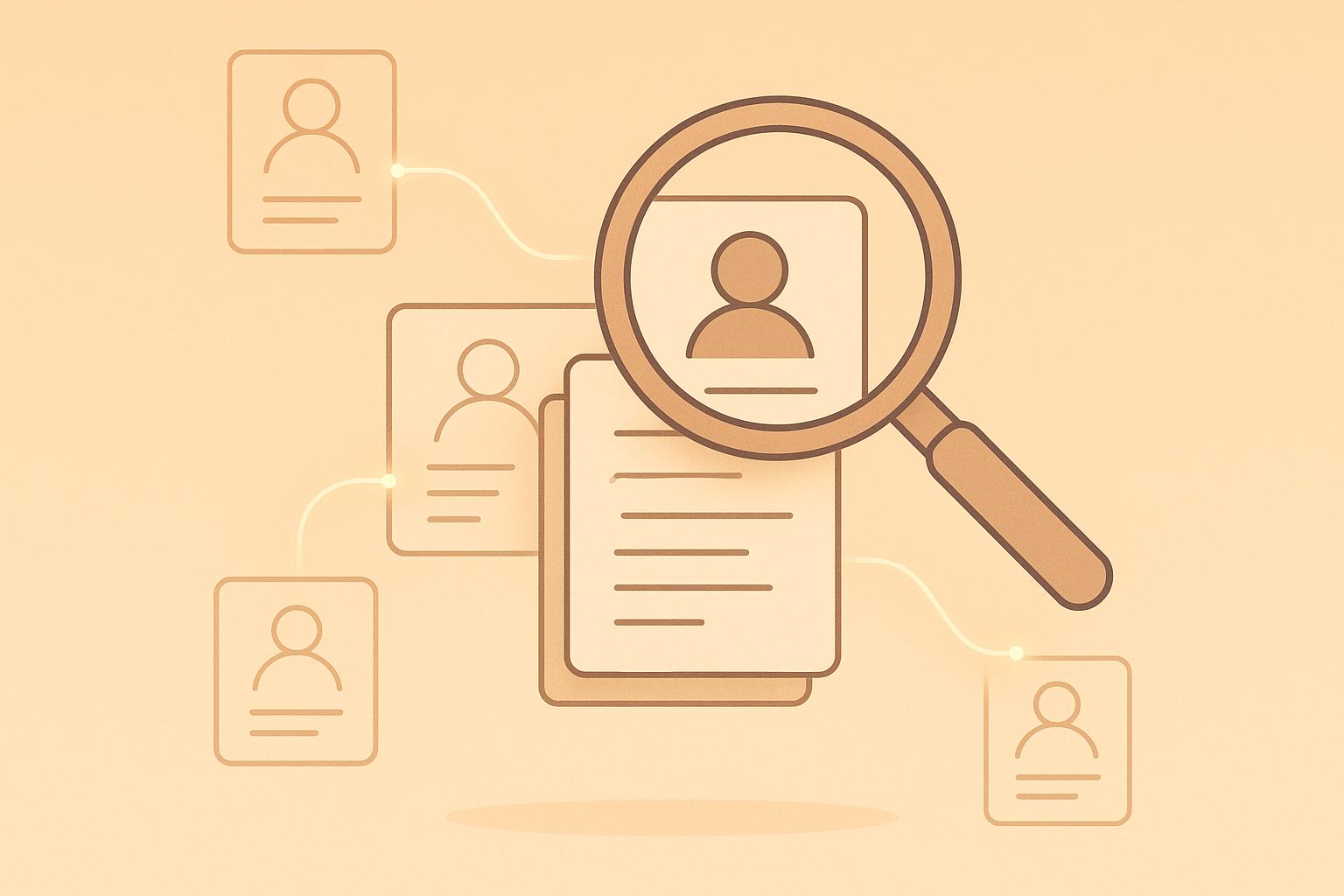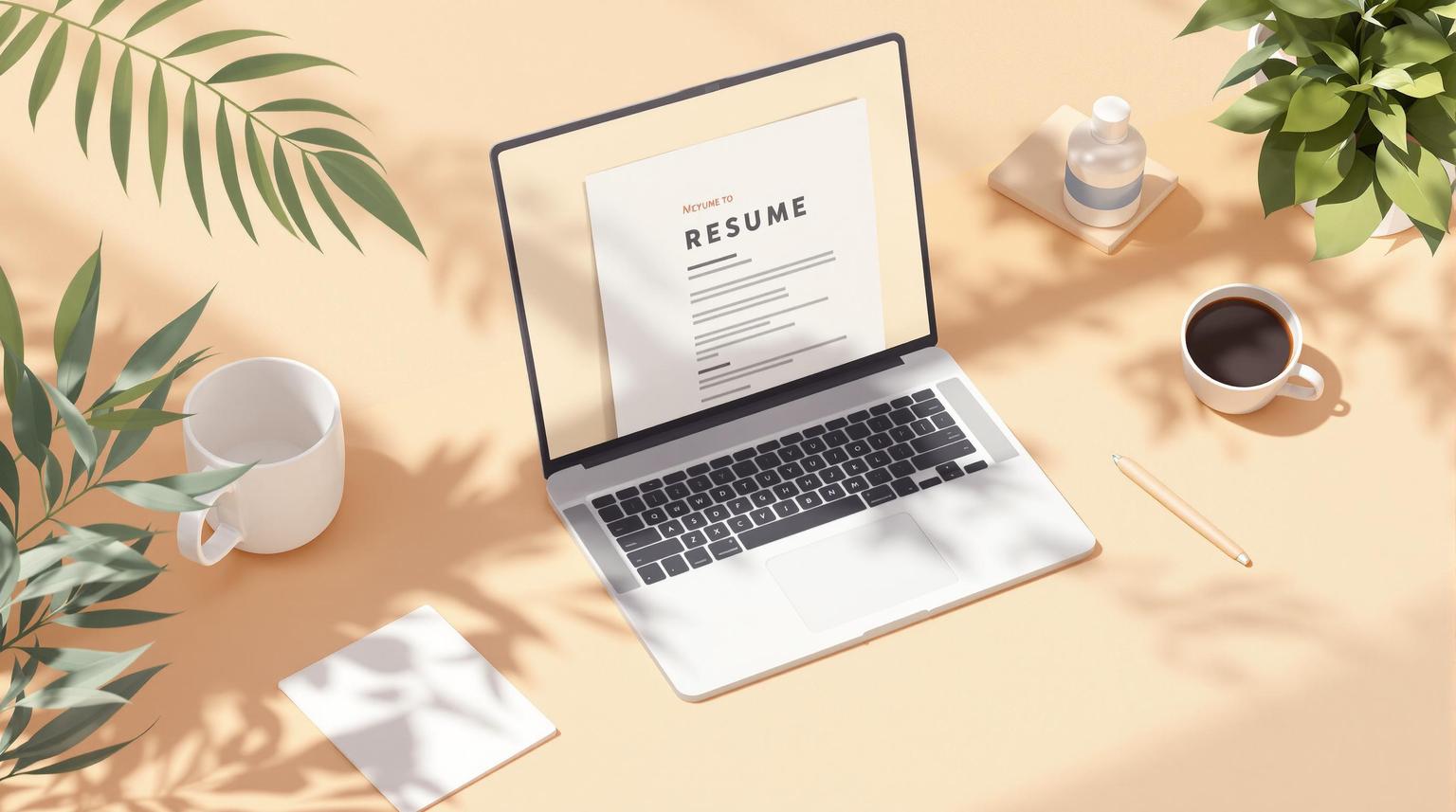AI is reshaping hiring by analyzing resumes, job descriptions, and other data to evaluate candidates quickly and objectively. Companies using AI in recruitment report faster hiring, reduced costs, and improved success rates. Here's how it works:
- Data Analysis: AI extracts key details from resumes, job descriptions, and even interviews to match candidates with roles.
- Scoring System: Candidates are evaluated based on skills, experience, and alignment with job requirements.
- Efficiency: Tasks like resume screening are completed in minutes, saving recruiters time and effort.
- Results: Companies using AI have reduced hiring time by up to 90% and improved hiring quality by 46%.
However, challenges like algorithmic bias and public skepticism remain. While AI excels at processing data, human oversight is still essential for nuanced decisions, like assessing emotional intelligence or team compatibility. Platforms like JobSwift.AI aim to improve both candidate and employer experiences by providing tools for optimized resumes and smarter evaluations.
How AI-Driven Resume Screening Systems Score You As A Job Candidate
Data Sources AI Uses for Evaluation
AI systems rely on a variety of data to accurately assess a candidate's potential. By analyzing multiple sources simultaneously, these systems create a well-rounded profile for each applicant. The quality and diversity of this data directly impact how effectively the AI can match candidates to roles. Let’s take a closer look at three key data inputs - resumes, job descriptions, and additional candidate information - that power AI-driven evaluations.
Resumes and CVs
Resumes are one of the main data sources for AI evaluation tools. Using natural language processing (NLP) and machine learning (ML), these tools transform unstructured resumes into structured formats like XML or JSON, making it easier to extract and analyze details such as contact information, work history, skills, and education - even across various layouts and formats.
For example, one company reported a 60% reduction in time spent on initial resume screening after adopting resume parsing technology. Another AI tool achieved a 92% AP50 score for information extraction, helping businesses save up to 70% of the time typically spent on manual tasks. Different industries also prioritize different data points: tech companies often focus on programming languages and technical expertise, while healthcare recruiters emphasize licensing and clinical certifications.
Job Descriptions
Job descriptions act as detailed guides for AI systems, outlining the specific skills and qualifications needed for a role. By analyzing these descriptions, AI can identify key requirements and even optimize job postings for better visibility. This process has been shown to boost candidate matching accuracy to 85%, compared to just 60% with traditional methods.
Additionally, AI-powered systems streamline the hiring process by reducing the time needed to shortlist candidates. Tasks that might take an hour manually can be completed in about 10 minutes with AI. Plus, these tools help avoid common pitfalls, like attracting underqualified applicants or discouraging top talent with unclear or overly demanding job requirements.
Other Data Inputs
AI doesn’t stop at resumes and job descriptions. It also pulls insights from other sources like interviews, cover letters, and even social media profiles. These unstructured inputs allow AI to assess factors like communication style, motivation, and alignment with company values. By leveraging NLP, AI can extract meaningful insights into a candidate’s professional interests and career goals.
This comprehensive approach explains why 75% of large enterprises now use AI in their hiring processes. These systems can cut resume review time by up to 90%, all while delivering deeper and more thorough evaluations than traditional screening methods.
How AI Scores Candidates: Step-by-Step Process
AI evaluates candidates through a structured process that mirrors human hiring techniques but with added efficiency and consistency. Each step builds upon the last, creating a thorough and objective evaluation system.
Job Requirement Analysis
The process starts with AI carefully analyzing the job description to grasp the role's specific needs. It identifies key distinctions between tasks, responsibilities, and skills. For example, it can separate technical skills like "Python programming" from soft skills such as "team collaboration" when reviewing a software developer position.
"Carefully analyzing job descriptions is an essential part of the job search process, as it enables you to understand the role comprehensively and helps you identify the skills, experiences, and accomplishments you want to emphasize in your application materials and interview responses." - Keith Spencer, Career Coach
AI also incorporates insights from industry reports to ensure job postings align with current trends and demands. It tracks which job listings attract the most attention and identifies the keywords that drive applications, helping to refine the job description for better engagement.
After this initial analysis, the AI moves on to evaluate candidate documents against these defined requirements.
Resume Parsing and Skill Matching
With job requirements in place, the AI focuses on parsing candidate resumes. It extracts and organizes information like skills, work experience, and education using standardized taxonomies. Advanced techniques such as semantic search, entity recognition, and sentiment analysis allow the system to interpret the context and quality of a candidate’s experience. For instance, it can recognize leadership experience from a phrase like "managed a team of developers", even if the word "leadership" isn't explicitly mentioned.
To verify skills, the AI may incorporate interactive assessments, coding tests, or simulations, ensuring candidates' abilities match their claims. These refined data points are then used in the final scoring phase.
Score Generation and Weighting
In the final step, AI consolidates all the gathered data into a standardized score that reflects a candidate's overall fit for the role. It assigns individual scores to categories like education, skills, and experience, which are then weighted based on the job's priorities. For example, a Customer Service role might prioritize communication and problem-solving skills, with extra emphasis on experience in fast-paced environments.
The system uses keyword matching, contextual analysis, and predictive analytics to fine-tune these scores. For instance, it might identify patterns in hiring data, such as higher success rates among candidates with call center experience, to adjust the weighting accordingly. On the flip side, resumes lacking key indicators may receive lower scores.
This data-driven process not only ensures alignment between candidates and job requirements but also highlights why companies using AI in hiring are 46% more likely to make successful hires. Additionally, 43% of recruiters report saving time as a major benefit of AI-powered hiring.
sbb-itb-96bfd48
Key Criteria Used in AI Candidate Scoring
AI evaluates candidates across three main areas to create a well-rounded profile. These dimensions - technical skills, practical experience, and alignment with company values - work together to give recruiters deeper insights that go beyond traditional resume screening.
Skills and Knowledge
AI systems are particularly adept at identifying and evaluating technical expertise by analyzing various data points from candidate profiles. They go beyond simple keyword matching to identify specific skills and experiences that align with job requirements.
For example, modern AI can infer skill proficiency from a candidate’s work history and accomplishments. If a profile mentions "optimized database queries resulting in 40% faster load times", the AI recognizes both SQL expertise and performance optimization skills, even if these skills aren’t explicitly listed.
Additionally, AI assesses technical skills through practical evaluations. This allows recruiters to identify candidates who have the necessary abilities, regardless of whether they gained them through formal education, independent learning, or hands-on projects.
"AI enables us to process this large number of applications without missing any amazingly talented candidates." - Ezequiel Ruiz, Vice President of Talent Acquisition, BairesDev
This approach has transformed hiring processes, with 87% of companies now using AI-driven tools to improve candidate quality.
Experience and Relevance
AI also evaluates candidates’ work history to determine how well their background matches the role’s requirements. By focusing on measurable qualifications, the technology creates objective compatibility ratings, removing bias from the equation.
Using tools like OCR and GPT-4, AI extracts and analyzes data to calculate alignment scores between candidates and positions. It even highlights skill gaps, helping recruiters pinpoint areas where candidates excel and where they might need further development.
This method has proven highly effective. For instance, Unilever streamlined its hiring process, cutting it down from four months to just four weeks. By using AI to handle nearly 2 million job applications each year, the company saved over 100,000 hours of recruitment time.
Soft Skills and Company Fit
One of the most advanced aspects of AI candidate scoring involves assessing interpersonal skills and alignment with company values. This is critical, as 89% of hiring failures result from cultural mismatches rather than skill deficiencies.
AI evaluates communication, confidence, and emotional intelligence by analyzing written responses and interview transcripts. It examines tone, clarity, and interaction style, offering insights into how candidates might collaborate with team members.
"Early-stage screening is where most hiring goes wrong. The best recruiters are looking for communication patterns that predict team success before investing in interviews. When done right, AI helps catch what humans miss when rushing through hundreds of applications." - Abhinav Chugh, CEO of Peoplebox.ai
Using Natural Language Processing (NLP) and behavioral analytics, AI platforms assess candidates’ problem-solving abilities, communication styles, and behavioral traits. These systems can even be customized to reflect a company’s specific values and teamwork norms, creating a more tailored evaluation process.
This holistic approach explains why candidates selected by AI are 14% more likely to pass interviews and 18% more likely to accept job offers compared to those identified through traditional methods. Companies like Unilever have seen a 16% increase in diversity and up to a 40% reduction in time-to-hire after adopting AI-driven recruitment systems.
Benefits and Limitations of AI Candidate Scoring
AI scoring is reshaping how organizations evaluate job candidates, offering a mix of groundbreaking advantages and notable challenges. Understanding these trade-offs is critical for businesses considering AI-driven recruitment systems.
Advantages of AI Scoring
AI candidate scoring has introduced significant improvements in recruitment processes. For starters, it drastically cuts screening time - saving up to 23 hours per hire - which translates to lower costs and greater efficiency.
The financial savings are hard to ignore. Companies have reported up to 67% reductions in hiring costs. A standout example is General Motors, which saved $2 million by automating 74,000 interviews and engaging with nearly one million candidates .
Beyond cost and time, AI improves hiring quality by around 52%, thanks to its ability to match candidates more accurately to job requirements. Unlike traditional methods, AI processes large volumes of data without bias, ensuring a more objective screening process.
AI also excels at keeping candidates engaged around the clock. Nestlé, for example, uses AI to handle 1.5 million candidate queries, schedule 25,000 interviews, and save 8,000 hours per month through 24/7 support.
Sean Behr, CEO of Fountain, highlights this efficiency:
"The AI agent is designed to figure out if you're a good fit for the job, and frankly, I think it does a better job than humans. It does it faster and more effectively, and it does it in a bias-free way."
Despite these advantages, AI scoring is not without its challenges, which require thoughtful consideration.
Limitations to Consider
While AI scoring offers efficiency, it also comes with some serious challenges. Algorithmic bias is one of the biggest concerns. For instance, in 2018, a global tech company discontinued its AI recruitment tool after discovering it favored male candidates over female ones. Similarly, in 2014, Amazon's hiring tool downgraded applications that included the word "female".
Public trust in AI is another hurdle. Research by Gallup shows that 85% of Americans are concerned about using AI in hiring, and 71% oppose AI making final hiring decisions. This skepticism can negatively impact both candidate experience and employer reputation.
AI systems also face limitations in handling complex, nuanced evaluations like assessing emotional intelligence or cultural fit - areas where human recruiters naturally excel. Moreover, the effectiveness of these systems depends heavily on the quality of their training data. If the data is biased or incomplete, it can lead to discriminatory outcomes unless frequent audits and updates are conducted.
Comparison Table: Benefits vs. Limitations
| Benefits | Limitations |
|---|---|
| Speed: Saves up to 23 hours per hire on screening | Algorithmic Bias: Risk of perpetuating discrimination if training data is flawed |
| Cost Reduction: Up to 67% reduction in hiring costs | Public Skepticism: Strong opposition to AI making hiring decisions |
| Quality Improvement: 52% increase in quality of hire | Limited EQ Assessment: Struggles with evaluating emotional intelligence and cultural fit |
| 24/7 Availability: Continuous candidate engagement | Data Dependency: Performance relies on high-quality training data |
| Objectivity: Reduces bias in initial screening | Regulatory Compliance: Navigating complex AI hiring laws |
| Scalability: Handles large volumes of applications efficiently | Over-reliance Risk: Potential loss of the human touch in hiring processes |
To make the most of AI in recruitment, companies need to strike a balance - leveraging the speed and efficiency of AI while maintaining human oversight. This hybrid approach ensures technology enhances, rather than replaces, human judgment in the hiring process.
Conclusion: The Future of AI in Recruitment
AI-powered candidate scoring is transforming how talent is evaluated, and its influence is growing rapidly. What was once experimental is now becoming a standard practice across industries.
Key Takeaways
A growing number of organizations - 37%, compared to 27% last year - are incorporating or testing GenAI tools in their hiring processes. Among recruiters using AI, 86.1% report faster hiring cycles, and companies have seen cost-per-hire drop by up to 30%.
The future of hiring is shifting toward skills-based assessments, with AI playing a central role in evaluating candidates' abilities rather than relying solely on traditional qualifications. Companies prioritizing skills-based searches are 12% more likely to make quality hires. Additionally, 61% of talent acquisition experts believe AI improves their ability to measure the quality of hires.
AI-assisted messaging is also making a difference, with recruiters using it being 9% more likely to secure quality hires. This underscores that AI isn’t about replacing human judgment but enhancing it.
As Glen Cathey from Randstad explains:
"AI is a tool to augment human judgment, not replace it. Successful organizations will find the right balance - using AI to handle routine tasks and consider complex problems, while preserving meaningful human interaction where it matters most."
The role of recruiters is evolving alongside these technological advancements. John Vlastelica, founder and CEO of Recruiting Toolbox, foresees recruiters taking on more personalized roles:
"They will be much more of a career coach, working with candidates who have more complicated situations. They will be providing more of an executive recruiter kind of experience."
AI is expected to handle repetitive tasks, freeing up recruiters to focus on higher-value, strategic activities. Beyond efficiency, AI also holds promise for creating more inclusive and personalized hiring experiences and reducing bias in recruitment.
These advancements pave the way for a more tailored and supportive hiring process, setting the stage for platforms that bridge the gap between candidates and opportunities.
How JobSwift.AI Helps Candidates

As recruitment evolves, JobSwift.AI is equipping candidates with tools to navigate this new landscape. With 58% of job seekers already using AI tools during their job search, having the right technology is more important than ever.
JobSwift.AI’s upcoming AI CV optimization feature helps candidates align their resumes with the criteria used by AI scoring systems. Its AI-driven employer insights provide valuable details about company preferences, while the job application dashboard and automatic tracking features keep candidates organized in a complex application process.
Eric Dozier from Eli Lilly highlights the potential of AI in connecting candidates to opportunities:
"The more we can leverage AI to assess your skills and match you with different jobs, the more you can be successful - to me, that's exciting."
The future of recruitment lies in a partnership between human expertise and artificial intelligence. While AI handles data analysis and initial screenings, platforms like JobSwift.AI empower candidates to present their strengths effectively and navigate the hiring process with confidence. Success in this evolving landscape requires not just understanding AI but also leveraging the right tools to stay ahead.
FAQs
How does AI evaluate candidates fairly and avoid bias in scoring?
AI helps create more equitable candidate evaluations by using carefully designed fairness metrics and processes. These include steps like pre-processing, where input data is reviewed and adjusted to remove bias, in-processing, which involves refining algorithms during training to ensure fairness, and post-processing, where results are analyzed and corrected for any disparities that may arise.
To maintain fairness over time, regular bias assessments and continuous monitoring are crucial. Together, these methods work to ensure AI systems deliver objective and fair evaluations for every candidate.
What data does AI use to evaluate a candidate's potential, and how does it ensure accurate scoring?
AI assesses a candidate's potential by examining multiple data points, such as resumes, interview responses, job application details, and even digital footprints. These inputs are run through sophisticated machine learning algorithms to produce objective, data-based evaluations.
By focusing on quantifiable and neutral information, AI improves the precision of its scoring process. Over time, it gets better through feedback and real-world performance results, making it easier to pinpoint strong candidates while minimizing the influence of human bias in hiring decisions.
How can I optimize my resume to improve its AI scoring and increase my chances of being shortlisted?
To improve your resume's performance with AI screening tools and increase your chances of getting shortlisted, focus on aligning it with the job description. Use keywords directly from the job listing, highlight your most relevant skills and accomplishments, and stick to a simple, consistent layout. Avoid using graphics, special characters, or intricate designs, as these can confuse AI systems.
Take the time to proofread thoroughly. Spelling and grammar mistakes can hurt your score and reduce your chances of standing out. By following these AI-friendly strategies, you can enhance your resume's visibility and make a stronger impact.


